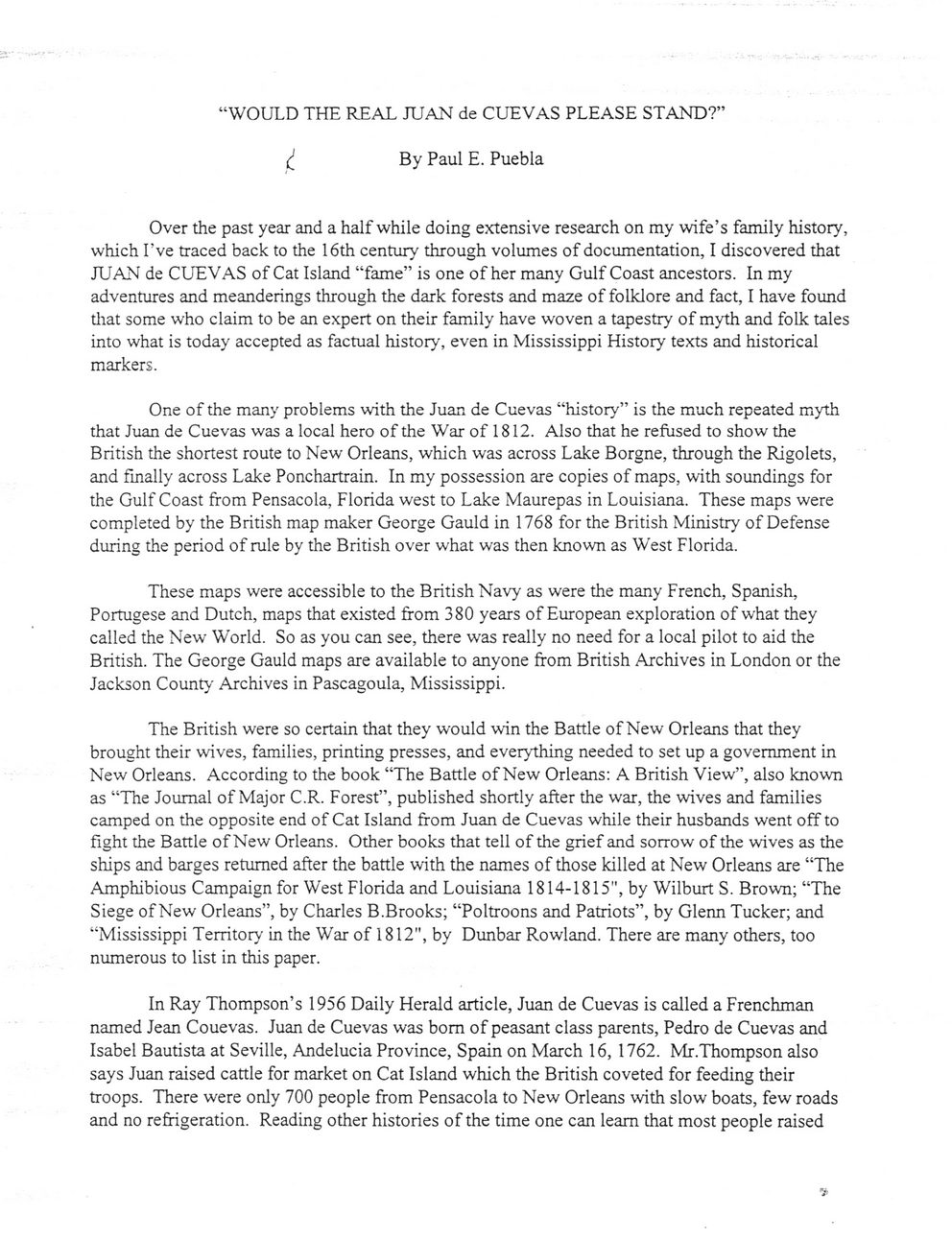This text was obtained via automated optical character recognition.
It has not been edited and may therefore contain several errors.
?WOULD THE REAL JUAN de CUEVAS PLEASE STAND?? ^ By Paul E. Puebla Over the past year and a half while doing extensive research on my wife?s family history, which I?ve traced back to the 16th century through volumes of documentation, I discovered that JUAN de CUEVAS of Cat Island ?fame? is one of her many Gulf Coast ancestors. In my adventures and meanderings through the dark forests and maze of folklore and fact, I have found that some who claim to be an expert on their family have woven a tapestry of myth and folk tales into what is today accepted as factual history, even in Mississippi History texts and historical markers. One of the many problems with the Juan de Cuevas ?history? is the much repeated myth that Juan de Cuevas was a local hero of the War of 1812. Also that he refused to show the British the shortest route to New Orleans, which was across Lake Borgne, through the Rigolets, and finally across Lake Ponchartrain. In my possession are copies of maps, with soundings for the Gulf Coast from Pensacola, Florida west to Lake Maurepas in Louisiana. These maps were completed by the British map maker George Gauld in 1768 for the British Ministry of Defense during the period of rule by the British over what was then known as West Florida. These maps were accessible to the British Navy as were the many French, Spanish, Portugese and Dutch, maps that existed from 380 years of European exploration of what they called the New World. So as you can see, there was really no need for a local pilot to aid the British. The George Gauld maps are available to anyone from British Archives in London or the Jackson County' Archives in Pascagoula, Mississippi. The British were so certain that they would win the Battle of New Orleans that they brought their wives, families, printing presses, and everything needed to set up a government in New Orleans. According to the book ?The Battle of New Orleans: A British View?, also known as ?The Journal of Major C.R. Forest?, published shortly after the war, the wives and families camped on the opposite end of Cat Island from Juan de Cuevas while their husbands went off to fight the Battle of New Orleans. Other books that tell of the grief and sorrow of the wives as the ships and barges returned after the battle with the names of those killed at New Orleans are ?The Amphibious Campaign for West Florida and Louisiana 1814-1815", by Wilburt S. Brown; ?The Siege of New Orleans?, by Charles B.Brooks; ?Poltroons and Patriots?, by Glenn Tucker; and ?Mississippi Territory in the War of 1812", by Dunbar Rowland. There are many others, too numerous to list in this paper. In Ray Thompson?s 1956 Daily Herald article, Juan de Cuevas is called a Frenchman named Jean Couevas. Juan de Cuevas was bom of peasant class parents, Pedro de Cuevas and Isabel Bautista at Seville, Andelucia Province, Spain on March 16, 1762. Mr.Thompson also says Juan raised cattle for market on Cat Island which the British coveted for feeding their troops. There were only 700 people from Pensacola to New Orleans with slow boats, few roads and no refrigeration. Reading other histories of the time one can learn that most people raised

Cuevas 072